Kutz M. Handbook of materials selection
Подождите немного. Документ загружается.


944 METAL FORMING, SHAPING, AND CASTING
of curvature. Supports can be swung clear to permit removal of a closed shape
from the rolls. Bending rolls are available in a wide range of sizes, some being
capable of bending plate up to 6 in. (150 mm) thick.
Cold-Roll Forming
This process involves the progressive bending of metal strip as it passes through
a series of forming rolls. A wide variety of moldings, channeling, and other
shapes can be formed on machines that produce up to 10,000 ft (3000 m) of
product per day.
Seaming
Seaming is used to join ends of sheet metal to form containers such as cans,
pails, and drums. The seams are formed by a series of small rollers on seaming
machines that range from small hand-operated types to large automatic units
capable of producing hundreds of seams per minute in the mass production of
cans.
Flanging
Flanges can be rolled on sheet metal in essentially the same manner as seaming
is done. In many cases, however, the forming of flanges and seams involves
drawing, since localized bending occurs on a curved axis.
Straightening
Straightening or flattening has as its objective the opposite of bending and often
is done before other cold-forming operations to ensure that flat or straight ma-
terial is available. Two different techniques are quite common. Roll straightening
or roller leveling involves a series of reverse bends. The rod, sheet, or wire is
passed through a series of rolls having decreased offsets from a straight line.
These bend the metal back and forth in all directions, stressing it slightly beyond
its previous elastic limit and thereby removing all previous permanent set.
Sheet may also be straightened by a process called stretcher leveling. The
sheets are grabbed mechanically at each end and stretched slightly beyond the
elastic limit to remove previous stresses and thus produce the desired flatness.
3.4 Shearing
Shearing is the mechanical cutting of materials in sheet or plate form without
the formation of chips or use of burning or melting. When the two cutting blades
are straight, the process is called shearing. Other processes, in which the shear-
ing blades are in the form of curved edges or punches and dies, are called by
other names, such as blanking, piercing, notching, shaving, and trimming. These
all are basically shearing operations, however.
The required shear force can be calculated as
2
S ⫻ P ⫻ t ⫻ 12 P
F ⫽ 1 ⫺ (17)
冉冊冉冊
R 2
where F
⫽ shear force, lb
S
⫽ shear strength (stress), psi
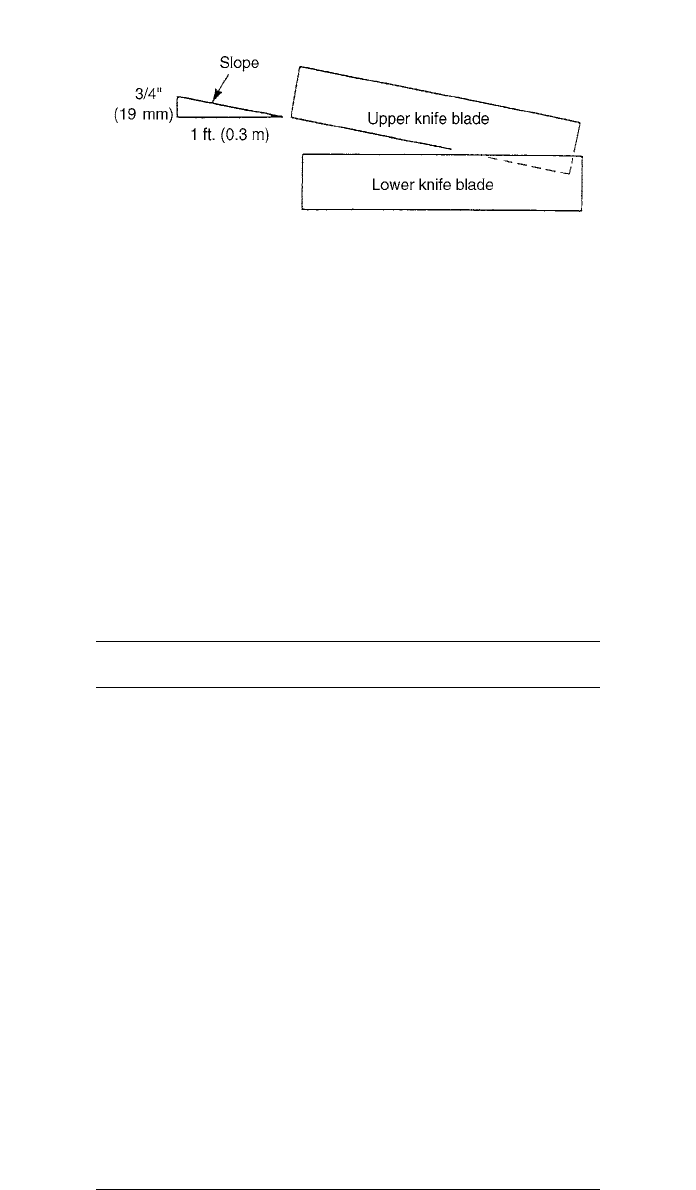
3 COLD-WORKING PROCESSES 945
Fig. 15 Rake is the angular slope formed by the cutting edges of the
upper and lower knives.
Table 2 Values of Percent Penetration and Shear Strength for
Various Materials
Material
Percent
Penetration
Shear Strength,
psi (MPa)
Lead alloys 50 3500 (24.1)–6000 (41.3)
Tin alloys 40 5000 (34.5)–10,000 (69)
Aluminum alloys 60 8000 (55.2)–45,000 (310)
Titanium alloys 10 60,000 (413)–70,000 (482)
Zinc 50 14,000 (96.5)
Cold worked 25 19,000 (131)
Magnesium alloys 50 17,000 (117)–30,000 (207)
Copper 55 22,000 (151.7)
Cold worked 30 28,000 (193)
Brass 50 32,000 (220.6)
Cold worked 30 52,000 (358.5)
Tobin bronze 25 36,000 (248.2)
Cold worked 17 42,000 (289.6)
Steel, 0.10C 50 35,000 (241.3)
Cold worked 38 43,000 (296.5)
Steel, 0.40C 27 62,000 (427.5)
Cold worked 17 78,000 (537.8)
Steel, 0.80C 15 97,000 (668.8)
Cold worked 5 127,000 (875.6)
Steel, 1.00C 10 115,000 (792.9)
Cold worked 2 150,000 (1034.2)
Silicon steel 30 65,000 (448.2)
Stainless steel 30 57,000 (363)–128,000 (882)
Nickel 55 35,000 (241.3)
P ⫽ penetration of knife into material, %
t
⫽ thickness of material, in.
R
⫽ rake of the knife blade, in./ft (Fig. 15)
For SI units, the force is multiplied by 4.448 to obtain newtons (N). Table 2
gives the values of P and S for various materials.
Blanking
A blank is a shape cut from flat or preformed stock. Ordinarily, a blank serves
as a starting workpiece for a formed part; less often, it is a desired end product.

946 METAL FORMING, SHAPING, AND CASTING
Calculation of the forces and the work involved in blanking gives average
figures that are applicable only when (a) the correct shear strength for the ma-
terial is used, and (b) the die is sharp and the punch is in good condition, has
correct clearance, and is functioning properly.
The total load on the press, or the press capacity required to do a particular
job, is the sum of the cutting force and other forces acting at the same time,
such as the blankholding force exerted by a die cushion.
Cutting Force: Square-End Punches and Dies
When punch and die surfaces are flat and at right angles to the motion of the
punch, the cutting force can be found by multiplying the area of the cut section
by the shear strength of the work material:
L
⫽ Stl (18)
where L
⫽ load on the press, lb (cutting force)
S
⫽ shear strength of the stock, psi
t
⫽ stock thickness, in.
l
⫽ the length or perimeter of cut, in.
Piercing
Piercing is a shearing operation wherein the shearing blades take the form of
closed, curved lines on the edges of a punch and die. Piercing is basically the
same as blanking except that the piece punched out is the scrap and the re-
mainder of the strip becomes the desired workpiece.
Lancing
Lancing is a piercing operation that may take the form of a slit in the metal or
an actual hole. The purpose of lancing is to permit adjacent metal to flow more
readily in subsequent forming operations.
Perforating
Perforating consists of piercing a large number of closely spaced holes.
Notching
Notching is essentially the same as piercing except that the edge of the sheet of
metal forms a portion of the periphery of the piece that is punched out. It is
used to form notches of any desired shape along the edge of a sheet.
Nibbling
Nibbling is a variation of notching in which a special machine makes a series
of overlapping notches, each farther into the sheet of metal.
Shaving
Shaving is a finished operation in which a very small amount of metal is sheared
away around the edge of a blanked part. Its primary use is to obtain greater
dimensional accuracy, but it also may be used to obtain a square of smoother
edge.

3 COLD-WORKING PROCESSES 947
Trimming
Trimming is used to remove the excess metal that remains after a drawing,
forging, or casting operation. It is essentially the same as blanking.
Cutoff
A cutoff operation is one in which a stamping is removed from a strip of stock
by means of a punch and die. The cutoff punch and die cut across the entire
width of the strip. Frequently, an irregularly shaped cutoff operation may si-
multaneously give the workpiece all or part of the desired shape.
Dinking
Dinking is a modified shearing operation that is used to blank shapes from low-
strength materials, primarily rubber, fiber, and cloth.
3.5 Drawing
Cold Drawing
Cold drawing is a term that can refer to two somewhat different operations. If
the stock is in the form of sheet metal, cold drawing is the forming of parts
wherein plastic flow occurs over a curved axis. This is one of the most important
of all cold-working operations because a wide range of parts, from small caps
to large automobile body tops and fenders, can be drawn in a few seconds each.
Cold drawing is similar to hot drawing, but the higher deformation forces, thin-
ner metal, limited ductility, and closer dimensional tolerance create some dis-
tinctive problems.
If the stock is wire, rod, or tubing, cold drawing refers to the process of
reducing the cross section of the material by pulling it through a die, a sort of
tensile equivalent to extrusion.
Cold Spinning
Cold spinning is similar to hot spinning, discussed above.
Stretch Forming
In stretch forming, only a single male form block is required. The sheet of metal
is gripped by two or more sets of jaws that stretch it and wrap it around the
form block as the latter raises upward. Various combinations of stretching, wrap-
ping, and upward motion of the blocks are used, depending on the shape of the
part.
Shell or Deep Drawing
The drawing of closed cylindrical or rectangular containers, or a variation of
these shapes, with a depth frequently greater than the narrower dimension of
their opening, is one of the most important and widely used manufacturing
processes. Because the process had its earliest uses in manufacturing artillery
shells and cartridge cases, it is sometimes called shell drawing. When the depth
of the drawn part is less than the diameter, or minimum surface dimension, of
the blank, the process is considered to be shallow drawing. If the depth is greater
than the diameter, it is considered to be deep drawing.
The design of complex parts that are to be drawn has been aided considerably
by computer techniques, but is far from being completely and successfully
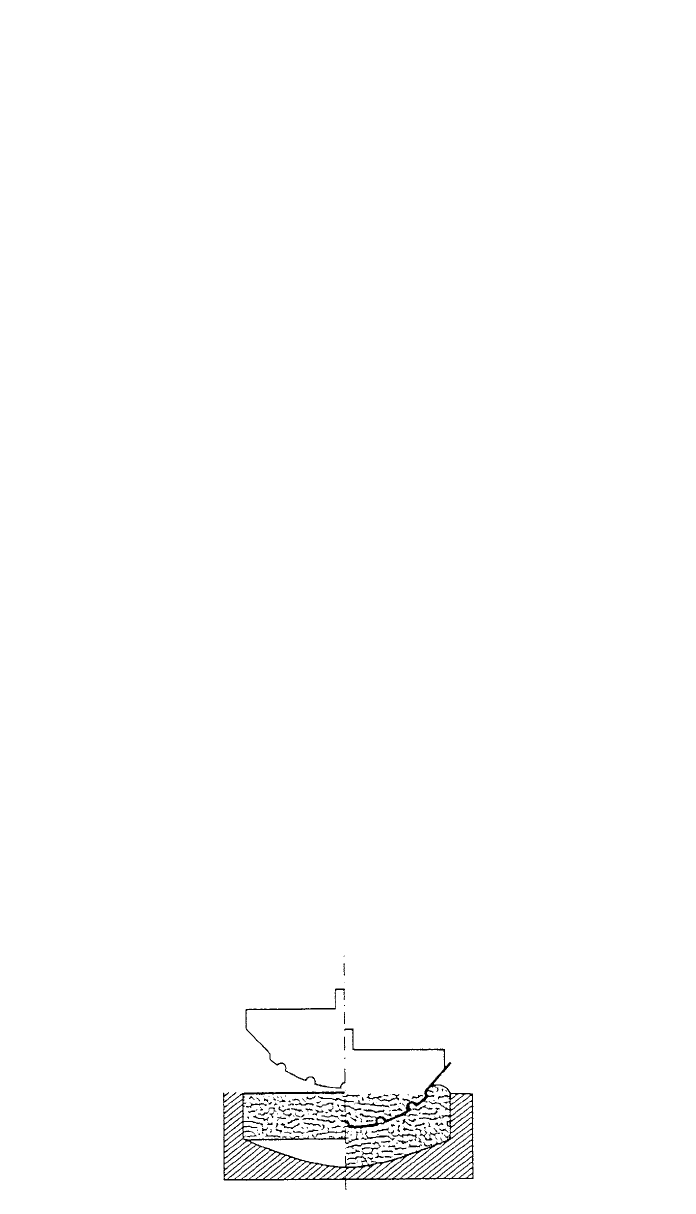
948 METAL FORMING, SHAPING, AND CASTING
Fig. 16 Form with rubber.
solved. Consequently, such design still involves a mix of science, experience,
empirical data, and actual experimentation. The body of known information is
quite substantial, however, and is being used with outstanding results.
Forming with Rubber or Fluid Pressure
Several methods of forming use rubber or fluid pressure (Fig. 16) to obtain the
desired information and thereby eliminate either the male or female member of
the die set. Blanks of sheet metal are placed on top of form blocks, which usually
are made of wood. The upper ram, which contains a pad of rubber 8–10 in.
(200–250 mm) thick in a steel container, then descends. The rubber pad is
confined and transmits force to the metal, causing it to bend to the desired shape.
Since no female die is used and form blocks replace the male die, die cost is
quite low.
The hydroform process or ‘‘rubber bag forming’’ replaces the rubber pad with
a flexible diaphragm backed by controlled hydraulic pressure. Deeper parts can
be formed with truly uniform fluid pressure.
The bulging oil or rubber is used for applying an internal bulging force to
expand a metal blank or tube outward against a female mold or die, thereby
eliminating the necessity for a complicated, multiple-piece male die member.
Ironing
Ironing is the name given to the process of thinning the walls of a drawn cylinder
by passing it between a punch and a die where the separation is less than the
original wall thickness. The walls are elongated and thinned while the base
remains unchanged. The most common example of an ironed product is the thin-
walled all-aluminum beverage can.
Embossing
Embossing is a method for producing lettering or other designs in thin sheet
metal. Basically, it is a very shallow drawing operation, usually in open dies,
with the depth of the draw being from one to three times the thickness of the
metal.
High-Energy-Rate Forming
A number of methods have been developed for forming metals through the
release and application of large amounts of energy in a very short interval (Fig.
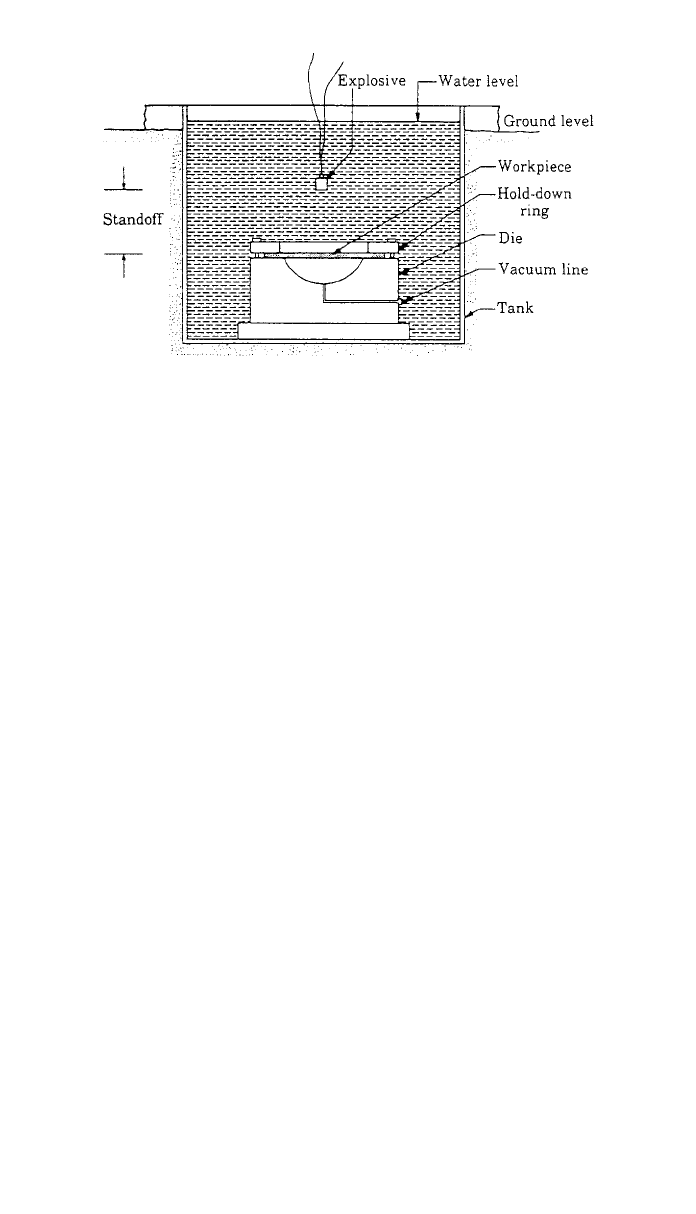
4 METAL CASTING AND MOLDING PROCESSES 949
Fig. 17 High-energy-rate forming.
17). These processes are called high-energy-rate forming processes (HERF).
Many metals tend to deform more readily under the ultrarapid rates of load
application used in these processes, a phenomenon apparently related to the
relative rates of load application and the movement of dislocations through the
metal. As a consequence, HERF makes it possible to form large workpieces and
difficult-to-form metals with less expensive equipment and tooling than would
otherwise be required.
The high energy-release rates are obtained by five methods:
1. Underwater explosions
2. Underwater spark discharge (electrohydraulic techniques)
3. Pneumatic–mechanical means
4. Internal combustion of gaseous mixtures
5. Rapidly formed magnetic fields (electromagnetic techniques)
4 METAL CASTING AND MOLDING PROCESSES
Casting provides a versatility and flexibility that have maintained casting position
as a primary production method for machine elements. Casting processes are
divided according to the specific type of molding method used in casting, as
follows:
1. Sand
2. Centrifugal
3. Permanent
4. Die
5. Plaster-mold
6. Investment
4.1 Sand Casting
Sand casting consists basically of pouring molten metal into appropriate cavities
formed in a sand mold (Fig. 18). The sand may be natural, synthetic, or an
artificially blended material.
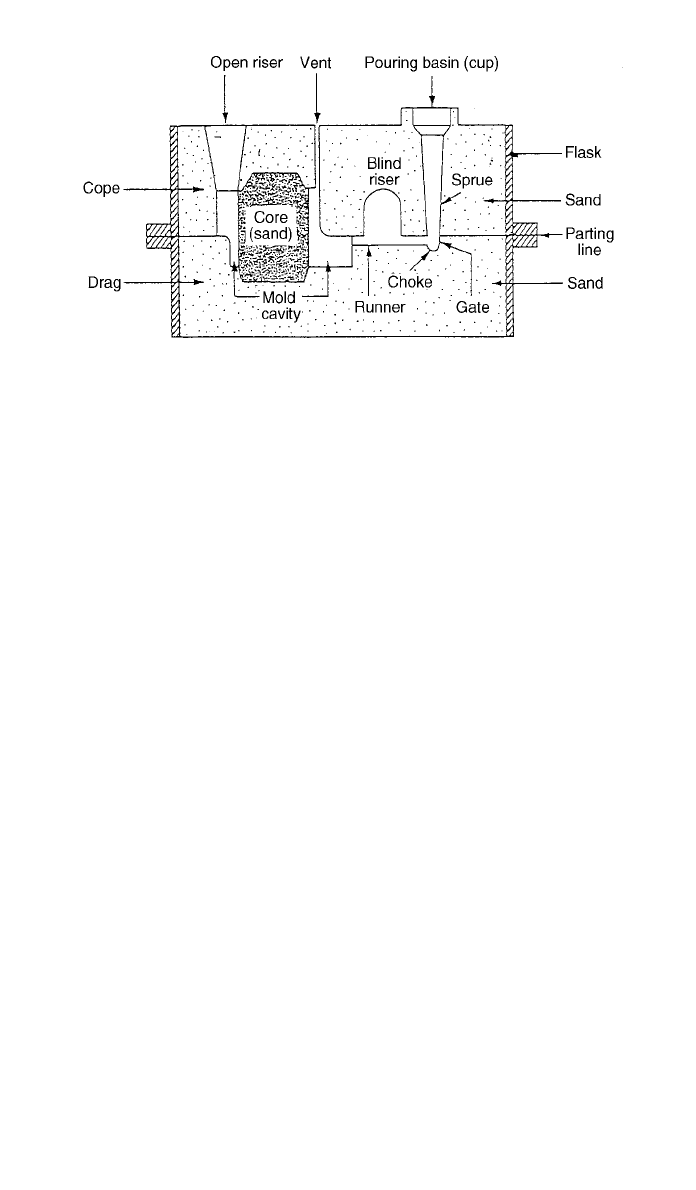
950 METAL FORMING, SHAPING, AND CASTING
Fig. 18 Sectional view of casting mold.
Molds
The two common types of sand molds are the dry sand mold and the green sand
mold. In the dry sand mold, the mold is dried thoroughly prior to closing and
pouring, while the green sand mold is used without any preliminary drying.
Because the dry sand mold is more firm and resistant to collapse than the green
sand mold, core pieces for molds are usually made in this way. Cores are placed
in mold cavities to form the interior surfaces of castings.
Patterns
To produce a mold for a conventional sand-cast part, it is necessary to make a
pattern of the part. Patterns are made from wood or metal to suit a particular
design, with allowances to compensate for such factors as natural metal shrink-
age and contraction characteristics. These and other effects, such as mold resis-
tance, distortion, casting design, and mold design, which are not entirely within
the range of accurate prediction, generally make it necessary to adjust the pattern
in order to produce castings of the required dimensions.
Access to the mold cavity for entry of the molten metal is provided by sprues,
runners, and gates.
Shrinkage
Allowances must be made on patterns to counteract the contraction in size as
the metal cools. The amount of shrinkage is dependent on the design of the
coating, type of metal used, solidification temperature, and mold resistance. Ta-
ble 3 gives average shrinkage allowance values used in sand casting. Smaller
values apply generally to large or cored castings of intricate design. Larger
values apply to small to medium simple castings designed with unrestrained
shrinkage.
Machining
Allowances are required in many cases because of unavoidable surface impuri-
ties, warpage, and surface variations. Average machining allowances are given
in Table 4. Good practice dictates use of minimum section thickness compatible

4 METAL CASTING AND MOLDING PROCESSES 951
Table 3 Pattern Shrinkage
Allowance (in./ ft)
Metal Shrinkage
Aluminum alloys
–
15
–– ––
10 32
Beryllium copper
–
15
–––
832
Copper alloys
–
37
–– ––
16 32
Everdur
3
––
16
Gray irons
1
–
8
Hastelloy alloys
1
–
4
Magnesium alloys
–
111
–––
864
Malleable irons
–
13
–– ––
16 16
Meehanite
–
15
–– ––
10 32
Nickel and nickel alloys
1
–
4
Steel
–
11
––
84
White irons
–
31
–– –
16 4
Table 4 Machining Allowances for Sand Castings (in.)
Metal Casting Size (in.) Finish Allowance
Cast irons
Up to 12
3
––
32
13–24
1
–
8
25–42
3
––
16
43–60
1
–
4
61–80
5
––
16
81– 120
3
–
8
Cast steels
Up to 12
1
–
8
13–24
3
––
16
25–42
5
––
16
43–60
3
–
8
61–80
7
––
16
81– 120
1
–
2
Malleable irons
Up to 8
1
––
16
9–12
3
––
32
13–24
1
–
8
25–36
3
––
16
Nonferrous metals
Up to 12
1
––
16
13–24
1
–
8
25–36
5
––
32
with the design. The normal minimum section recommended for various metals
is shown in Table 5.
4.2 Centrifugal Casting
Centrifugal casting consists of having a sand, metal, or ceramic mold that is
rotated at high speeds. When the molten metal is poured into the mold, it is
thrown against the mold wall, where it remains until it cools and solidifies. The
process is increasingly being used for such products as cast-iron pipes, cylinder
liners, gun barrels, pressure vessels, brake drums, gears, and flywheels. The
metals used include almost all castable alloys. Most dental tooth caps are made
by a combined lost-wax process and centrifugal casting.
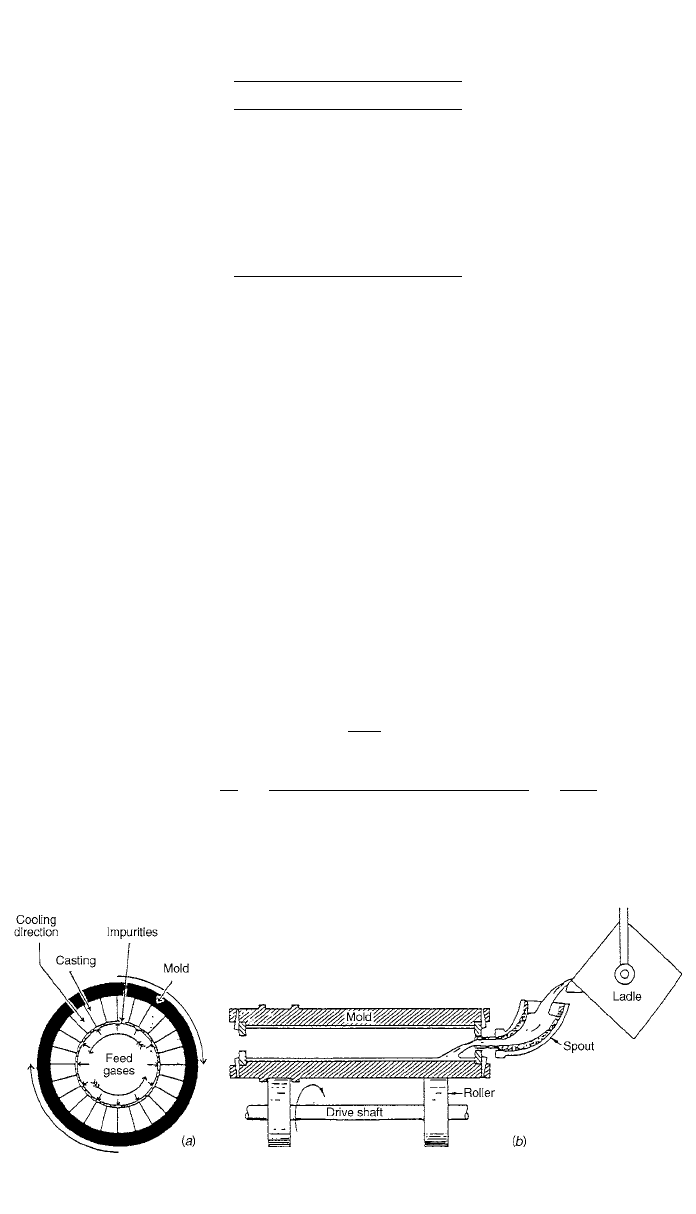
952 METAL FORMING, SHAPING, AND CASTING
Table 5 Minimum Sections
for Sand Castings (in.)
Metal Section
Aluminum alloys
3
––
16
Copper alloys
3
––
32
Gray irons
1
–
8
Magnesium alloys
5
––
32
Malleable irons
1
–
8
Steels
1
–
4
White irons
1
–
8
Fig. 19 Principle of centrifugal casting is to produce the high-grade metal by throwing the
heavier metal outward and forcing the impurities to congregate inward (a). Shown at (b)isa
schematic of how a horizontal-bond centrifugal casting is made.
Advantages and Limitations
Because of the relatively fast cooling time, centrifugal castings have a fine grain
size. There is a tendency for the lighter nonmetallic inclusion, slag particles, and
dross to segregate toward the inner radius of the castings (Fig. 19), where it can
be easily removed by machining. Owing to the high purity of the outer skin,
centrifugally cast pipes have a high resistance to atmospheric corrosion. Figure
19 shows a schematic sketch of how a pipe would be centrifugally cast in a
horizontal mold.
Parts that have diameters exceeding their length are produced by vertical-axis
casting (see Fig. 20).
If the centrifugal force is too low or too great, abnormalities will develop.
Most horizontal castings are spun so that the force developed is about 65g.
Vertically cast parts force is about 90–100g.
The centrifugal force (CF) is calculated from
2
mv
CF ⫽ lb
r
W Weight, lb W
m ⫽ Mass ⫽⫽ ⫽
2
g Acceleration of gravity (ft/s) 32.2
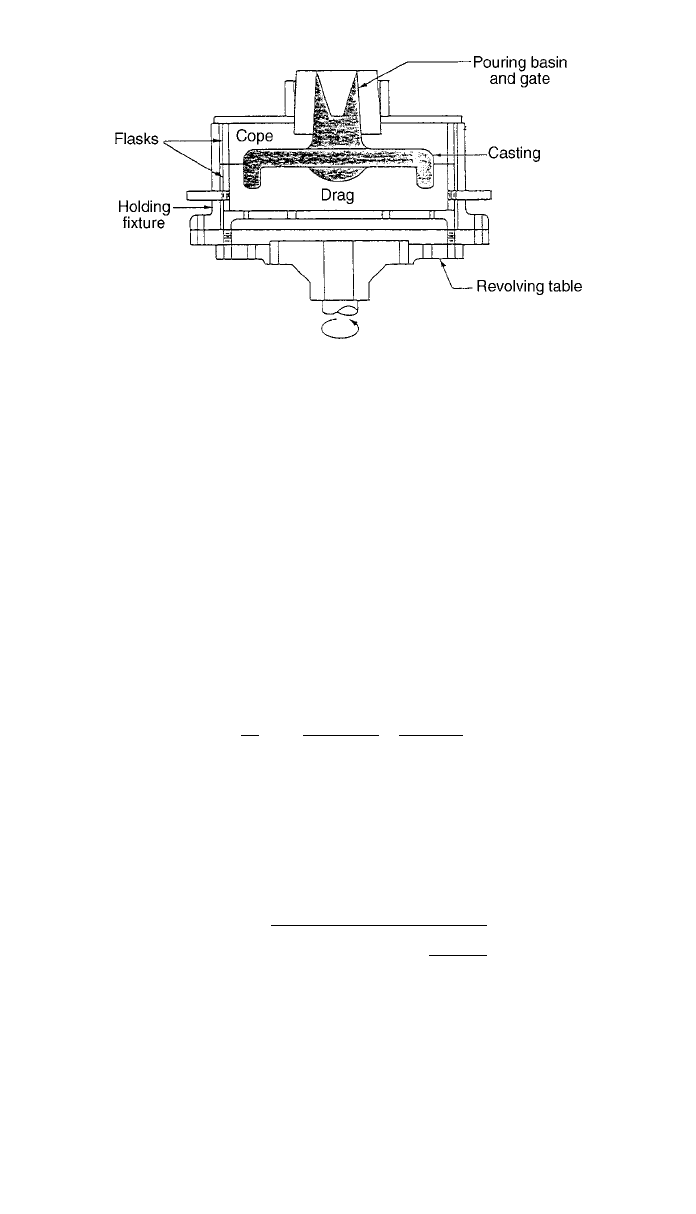
4 METAL CASTING AND MOLDING PROCESSES 953
Fig. 20 Floor-type vertical centrifugal casting machine for large-diameter parts.
where v ⫽ velocity, ft/s ⫽ r ⫻ w
r
⫽
radius, ft ⫽ D
1
–
2
W ⫽ angular velocity, rad/s
W
⫽ 2
/60 ⫻ rpm
D
⫽ inside diameter, ft
The number of g is
g
⫽ CF/W
Hence,
2
1 Wr⫻ 2
g ⫽⫻
冋冉冊册
W 32.2 ⫻ r 60
⫺
42
⫽ r ⫻ 3.41 ⫻ 10 rpm
⫺
42
⫽ 1.7 ⫻ 10 ⫻ D ⫻ (rpm)
The spinning speed for horizontal-axis molds may be found in English units
from the equation
70,500
N ⫽ (Number of g) ⫻
冪
D
where N
⫽ rpm
D
⫽ inside diameter of mold, ft
4.3 Permanent-Mold Casting
As demand for quality castings in production quantities increased, the attractive
possibilities of metal molds brought about the development of the permanent-
mold process. Although not as flexible regarding design as sand casting, metal-
mold casting made possible the continuous production of quantities of casting
from a single mold as compared to batch production of individual sand molds.
